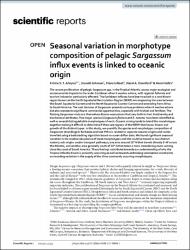| Sinopsis: | The recent proliferation of pelagic Sargassum spp. in the Tropical Atlantic causes major ecological and socioeconomic impacts to the wider Caribbean when it washes ashore, with regional fisheries and tourism industries particularly affected. The Caribbean influxes have been tracked to a new bloom region known as the North Equatorial Recirculation Region (NERR) encompassing the area between the South Equatorial Current and the North Equatorial Counter Current and extending from Africa to South America. The vast biomass of Sargassum presents serious problems when it washes ashore but also represents significant commercial opportunities, especially with biofuel and fertilizer. The floating Sargassum mats are themselves diverse ecosystems that vary both in their biodiversity and biochemical attributes. Two major species (Sargassum fluitans and S. natans) have been identified as well as several distinguishable morphotypes of each. Oceanic mixing tends to blend the morphotypes together making it difficult to determine if there are regions of the NERR that favour bloom and growth of the distinct types. In this study, we quantify the species and morphotype composition of Sargassum strandings in Barbados and test if this is related to separate oceanic origins and routes travelled using a backtracking algorithm based on ocean drifter data.
|
| Autor(es): | Alleyne, Kristie S. T.
Johnson, Donald
Neat, Francis
Oxenford, Hazel A.
Vallѐs, Henri
|
| Año: | 2023
|
| Publicado: | Scientific Reports, 13(1), 3753
|
| Citación: | Alleyne, K. S., Johnson, D., Neat, F., Oxenford, H. A., & Vallѐs, H. (2023). Seasonal variation in morphotype composition of pelagic Sargassum influx events is linked to oceanic origin. Scientific Reports, 13(1), 3753. Recuperado de:
|
| URI: | https://bvearmb.do/handle/123456789/2966
|


